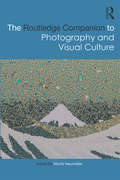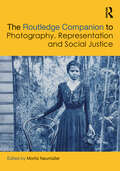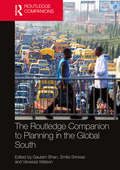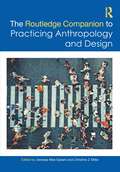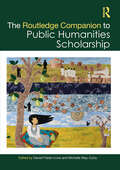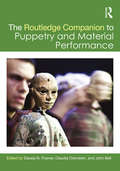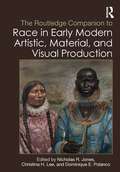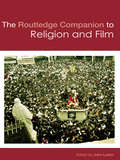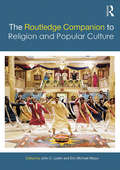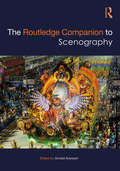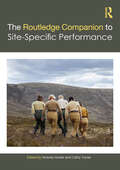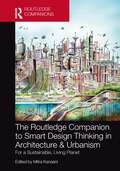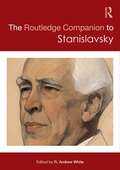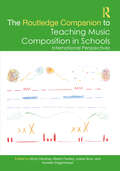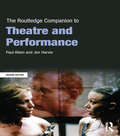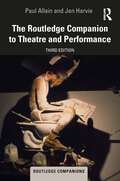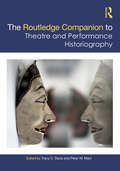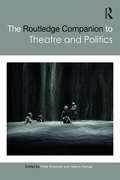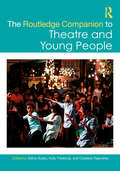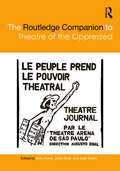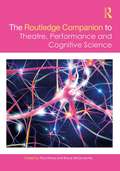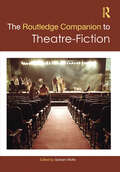- Table View
- List View
The Routledge Companion to Photography and Visual Culture (Routledge Art History and Visual Studies Companions)
by Moritz NeumüllerThe Routledge Companion to Photography and Visual Culture is a seminal reference source for the ever-changing field of photography. Comprising an impressive range of essays and interviews by experts and scholars from across the globe, this book examines the medium’s history, its central issues and emerging trends, and its much-discussed future. The collected essays and interviews explore the current debates surrounding the photograph as object, art, document, propaganda, truth, selling tool, and universal language; the perception of photography archives as burdens, rather than treasures; the continual technological development reshaping the field; photography as a tool of representation and control, and more. One of the most comprehensive volumes of its kind, this companion is essential reading for photographers and historians alike.
The Routledge Companion to Photography, Representation and Social Justice
by Moritz NeumüllerIncluding work by leading scholars, artists, scientists and practitioners in the field of visual culture, The Routledge Companion to Photography, Representation and Social Justice is a seminal reference source for the new roles and contexts of photography in the twenty-first century. Bringing together a diverse set of contributions from across the globe, the volume explores current debates surrounding post-colonial thinking, empowerment, identity, contemporary modes of self-representation, diversity in the arts, the automated creation and use of imagery in science and industry, vernacular imagery and social media platforms and visual mechanisms for control and manipulation in the age of surveillance capitalism and deep fakes, as well as the role of imagery in times of crisis, such as pandemics, wars and climate change. The analysis of these complex themes will be anchored in existing theoretical frameworks but also include new ways of thinking about social justice and representation and how to cope with our daily image tsunami. Individual chapters bring together a diverse set of contributions, featuring essays, interviews, conversations and case studies by artists, scientists, curators, scholars, medical doctors, astrophysicists and social activists, who all share a strong interest in how lens-based media have shaped our world in recent years. Expanding on contemporary debates within the field, the Companion is essential reading for photographers, scholars and students alike.
The Routledge Companion to Planning in the Global South (Routledge International Handbooks)
by Smita Srinivas Vanessa Watson Gautam BhanThe Routledge Companion to Planning in the Global South offers an edited collection on planning in parts of the world which, more often than not, are unrecognised or unmarked in mainstream planning texts. In doing so, its intention is not to fill a ‘gap’ that leaves this ‘mainstream’ unquestioned but to re-theorise planning from a deep understanding of ‘place’ as well as a commitment to recognise the diverse modes of practice that come within it. The chapters thus take the form not of generalised, ‘universal’ analyses and prescriptions, but instead are critical and located reflections in thinking about how to plan, act and intervene in highly complex city, regional and national contexts. Chapter authors in this Companion are not all planners, or are planners of very different kinds, and this diversity ensures a rich variety of insights, primarily based on cases, to emphasise the complexity of the world in which planning is expected to happen. The book is divided into a framing Introduction followed by five sections: planning and the state; economy and economic actors; new drivers of urban change; landscapes of citizenship; and planning pedagogy. This volume will be of interest to all those wanting to explore the complexities of planning practice and the need for new theories of knowledge from which to draw insight to face the challenges of the 21st century.
The Routledge Companion to Practicing Anthropology and Design
by Jenessa Mae Spears Christine Z MillerThe Routledge Companion to Practicing Anthropology and Design provides a comprehensive overview of the history of the relationship between these two fields and their current state, outlining key concepts and current debates as well as positing directions for future practice and research. Bringing together original work from a diverse group of established and emerging professionals, this volume joins a wider conversation about the trajectory of this transdisciplinary movement inspired by the continuing evolution of anthropology and design as they have adapted to accelerating and unpredictable conditions in arenas that span sectors, economies, socio-cultural groups, and geographies. It homes in on both the growing convergence and tensions between them while exploring how individuals from both fields have found ways of mixing, experimenting, and evolving theory and new forms of practice, highlighting the experimental theories and practices their transdisciplinarity has generated.The Routledge Companion to Practicing Anthropology and Design is a valuable reference tool for practitioners, scholars, and upper-level students in the fields of anthropology and design as well as related disciplines.
The Routledge Companion to Public Humanities Scholarship (Routledge Literature Companions)
by Daniel Fisher-Livne Michelle May-CurryAcross humanities disciplines, public scholarship brings academics and community members and organizations together in mutually-beneficial partnership for research, teaching, and programming. While the field of publicly engaged humanities scholarship has been growing for some time, there are few volumes that have attempted to define and represent its scope. The Routledge Companion to Public Humanities Scholarship brings together wide-ranging case studies sharing perspectives on this work, grounded in its practice in the United States.The collection begins with chapters reflecting on theories and practices of public humanities scholarship. The case studies that follow are organized around six areas of particular impact in public humanities scholarship: Informing contemporary debates; amplifying community voices and histories; helping individuals and communities navigate difficult experiences; preserving culture in times of crisis and change; expanding educational access; and building and supporting public scholarship. The Companion concludes with a glossary, introducing select concepts. Taken together, these resources offer an overview for students and practitioners of public humanities scholarship, creating an accessible vocabulary rooted in the practices that have so advanced academic and community life.Although drawing on case studies from the US, these examples offer perspectives and insights relevant to public humanities around the world. This book will be of interest to anyone working within the public humanities or wanting to make their work public and engage with wider communities.
The Routledge Companion to Puppetry and Material Performance (Routledge Companions)
by John Bell Claudia Orenstein Dassia N. PosnerThe Routledge Companion to Puppetry and Material Performance offers a wide-ranging perspective on how scholars and artists are currently re-evaluating the theoretical, historical, and theatrical significance of performance that embraces the agency of inanimate objects. This book proposes a collaborative, responsive model for broader artistic engagement in and with the material world. Its 28 chapters aim to advance the study of the puppet not only as a theatrical object but also as a vibrant artistic and scholarly discipline. This Companion looks at puppetry and material performance from six perspectives: theoretical approaches to the puppet, perspectives from practitioners, revisiting history, negotiating tradition, material performances in contemporary theatre, and hybrid forms. Its wide range of topics, which span 15 countries over five continents, encompasses: • visual dramaturgy • theatrical juxtapositions of robots and humans • contemporary transformations of Indonesian wayang kulit • Japanese ritual body substitutes • recent European productions featuring toys, clay, and food. The book features newly commissioned essays by leading scholars such as Matthew Isaac Cohen, Kathy Foley, Jane Marie Law, Eleanor Margolies, Cody Poulton, and Jane Taylor. It also celebrates the vital link between puppetry as a discipline and as a creative practice with chapters by active practitioners, including Handspring Puppet Company’s Basil Jones, Redmoon’s Jim Lasko, and Bread and Puppet’s Peter Schumann. Fully illustrated with more than 60 images, this volume comprises the most expansive English-language collection of international puppetry scholarship to date.
The Routledge Companion to Race in Early Modern Artistic, Material, and Visual Production (Routledge Art History and Visual Studies Companions)
by Nicholas R. Jones Christina H. Lee Dominique E. PolancoThis companion analyzes, frames, and provokes race in insightful ways that center non‑white communities’ artistic and visual expression in the early modern period, rather than presenting the bias of European artistic and visual depictions of the colonization, enslavement, and subordination of People of Color.The organization of the book moves chronologically, taking a conceptual and thematic framework. This collection provides a spectrum of object‑ased case studies of artistic production—bjects and object‑ypes—rom six continents between the 1400s and 1800s. Contributions take an art historical approach characterized by a close analysis of form, function, and meaning, with a particular focus on questions of cross‑ultural dialog and provenance. Additionally, there is an emphasis on material culture.The book will interest scholars working in African diaspora studies, art history, visual culture, material culture, Indigenous studies, Renaissance studies, musicology, early modern studies, decolonial studies, and race and racism studies.
The Routledge Companion to Religion and Film (Routledge Religion Companions)
by John LydenThe Routledge Companion to Religion and Film brings together a lively and experienced team of contributors to introduce students to the key topics in religion and film and to investigate the ways in which the exciting subject of religion and film is developing for more experienced scholars. Divided into four parts, the Companion: analyzes the history of the interaction of religion and film, through periods of censorship as well as appreciation of the medium studies religion-in-film, examining how the world’s major religions, as well as Postcolonial, Japanese and New Religions, are depicted by and within films uses diverse methodologies to explore religion and film, such as psychoanalytical, theological and feminist approaches, and audience reception analyzes religious themes in film, including Redemption, the Demonic, Jesus or Christ Figures, Heroes and Superheroes considers films as diverse as The Passion of the Christ, The Matrix, Star Wars and Groundhog Day. This definitive book provides an accessible resource to this emerging field and is an indispensable guide to religion and film for students of Religion, Film Studies, and beyond.
The Routledge Companion to Religion and Popular Culture (Routledge Religion Companions)
by John C. Lyden Eric Michael MazurReligion and popular culture is a fast-growing field that spans a variety of disciplines. This volume offers the first real survey of the field to date and provides a guide for the work of future scholars. It explores: key issues of definition and of methodology religious encounters with popular culture across media, material culture and space, ranging from videogames and social networks to cooking and kitsch, architecture and national monuments representations of religious traditions in the media and popular culture, including important non-Western spheres such as Bollywood This Companion will serve as an enjoyable and informative resource for students and a stimulus to future scholarly work.
The Routledge Companion to Scenography (Routledge Companions)
by Arnold AronsonThe Routledge Companion to Scenography is the largest and most comprehensive collection of original essays to survey the historical, conceptual, critical and theoretical aspects of this increasingly important aspect of theatre and performance studies. Editor and leading scholar Arnold Aronson brings together a uniquely valuable anthology of texts especially commissioned from across the discipline of theatre and performance studies. Establishing a stable terminology for a deeply contested term for the first time, this volume looks at scenography as the totality of all the visual, spatial and sensory aspects of performance. Tracing a line from Aristotle’s Poetics down to Brecht and Artaud and into contemporary immersive theatre and digital media, The Routledge Companion to Scenography is a vital addition to every theatre library.
The Routledge Companion to Site-Specific Performance (Routledge Companions)
by Victoria Hunter Cathy TurnerThis collection comprises a comprehensive overview of key themes, arguments, and practices central to the study and understanding of site-specific performance.Its collected essays, case studies, and practitioner accounts represent a must-have resource that engages with established and emergent ideas, themes, and practices central to this performance sub-discipline. Acknowledging the interdisciplinary nature of this field emergent through the creation and presentation of performance in non-theatre spaces, the companion includes writing from scholars whose work intersects with ideas from a range of related fields including dance, theatre, dramaturgy, human geography, architecture, walking studies, and archaeology. Alongside theoretical discussions and case study examples, a section on methods and structures allows site-specific practitioners to illustrate a range of practical approaches, tasks, and modes of producing site-specific performance in a range of sites.This interdisciplinary survey brings together practices and voices from a wide range of global contexts, demonstrating and challenging the breadth of site-specific discourse. It provides a rich palette of perspectives, approaches, and ideas for students, academics, and researchers to draw from.
The Routledge Companion to Smart Design Thinking in Architecture & Urbanism for a Sustainable, Living Planet
by Mitra KanaaniThis comprehensive companion surveys intelligent design thinking in architecture and urbanism, investigates multiple facets of "smart" approaches to design thinking that augment the potentials of user experiences as well as his/her physical and mental interactions with the built environment.Split into six paradigms, this volume looks at the theoretical and historical background of smart design, smart design methodologies and typologies, smart materials, smart design for extreme weather and climatic regions, as well as climate change issues and side effects, smart mobility, and the role of digital technologies and simulations in architectural and urban design. Often at odds with each other, this volume places emphasis on smart design for various typologies and user groups, emphasizing on advancements in form-making and implementation of technology for healthy and sustainable living environments.Written by emerging and established architects, planners, designers, scientists, and engineers from around the globe, this will be an essential reference volume for architecture and urban design students and scholars as well as those in related fields interested in the implications, various facets and futures of smart design.
The Routledge Companion to Stanislavsky (Routledge Companions Ser.)
by R. Andrew WhiteStanislavsky’s system of actor-training has revolutionised modern theatre practice, and he is widely recognised to be one of the great cultural innovators of the twentieth century. The Routledge Companion to Stanislavsky is an essential book for students and scholars alike, providing the first overview of the field for the 21st century. An important feature of this book is the balance between Stanislavsky’s theory and practice, as international contributors present scholarly and artistic interpretations of his work. With chapters including academic essays and personal narratives, the Companion is divided into four clear parts, exploring Stanislavsky on stage, as an acting teacher, as a theorist and finally as a theatre practitioner. Bringing together a dazzling selection of original scholarship, notable contributions include:Anatoly Smeliansky on Stanislavsky’s lettersWilliam D. Gunn on staging ideology at the Moscow Art TheatreSharon Marie Carnicke and David Rosen on opera Rosemary Malague on the feminist perspective of new translationsW.B. Worthen on cognitive scienceJulia Listengarten on the avant-gardeDavid Krasner on the System in America and Dennis Beck on Stanislavsky’s legacy in non-realistic theatre R. Andrew White is Associate Professor of Theatre at Valparaiso University, where he annually directs productions. He has an MFA in Acting from Carnegie Mellon University and the Moscow Art Theatre School, and has worked as an actor at a variety of theatres in the United States. In addition, his scholarship has appeared in edited works published by Routledge and Palgrave Macmillan, as well as in top American journals including Theatre Survey, TDR/The Drama Review, and New England Theatre Journal.
The Routledge Companion to Studio Performance Practice
by Franc ChamberlainThe Routledge Companion to Studio Performance Practice is a unique, indispensable guide to the training methods of the world’s key theatre practitioners. Compiling the practical work outlined in the popular Routledge Performance Practitioners series of guidebooks, each set of exercises has been edited and contextualised by an expert in that particular approach. Each chapter provides a taster of one practitioner’s work, answering the same key questions: ‘How did this artist work? How can I begin to put my understanding of this to practical use?’ Newly written chapter introductions put the exercises in context, explaining how they fit into the wider methods and philosophy of the practitioner in question. All 21 volumes in the original series are represented in this volume.
The Routledge Companion to Surrealism (Routledge Art History and Visual Studies Companions)
by Kirsten StromThis book provides a conceptual and global overview of the field of Surrealist studies. Methodologically, the companion considers Surrealism’s many achievements, but also its historical shortcomings, to illuminate its connections to the historical and cultural moment(s) from which it originated and to assess both the ways in which it still shapes our world in inspiring ways and the ways in which it might appear problematic as we look back at it from a twenty-first-century vantage point. Contributions from experienced scholars will enable professors to teach the subject more broadly, by opening their eyes to aspects of the field that are on the margins of their expertise, and it will enable scholars to identify new areas of study in their own work, by indicating lines of research at a tangent to their own. The companion will reflect the interdisciplinarity of Surrealism by incorporating discussions pertaining to the visual arts, as well as literature, film, and political and intellectual history.
The Routledge Companion to Teaching Music Composition in Schools: International Perspectives (Routledge Music Companions)
by Martin Fautley Kirsty Devaney Joana Grow Annette ZiegenmeyerThe Routledge Companion to Teaching Music Composition in Schools: International Perspectives offers a comprehensive overview of teaching composing from a wide range of countries around the world. Addressing the current state of composition pedagogy from primary to secondary school levels and beyond, the volume explores issues, including different curricular and extracurricular settings, cultural aspects of composing, aesthetics, musical creativity, the role of technology, and assessment. With contributors from over 30 countries, this volume encompasses theoretical, historical, empirical, and practical approaches and enables comparisons across different countries and regions. Chapters by experienced educators, composers, and researchers describe in depth the practices taking place in different international locations. Interspersed with these chapters, interludes by the volume editors contextualize and problematize the teaching and learning of composing music. The volume covers a range of contexts, including formal and informal, those where a national curriculum is mandated or where composing is a matter of choice, and a range of types, styles, and genres of musical learning and music-making. Providing a wide-ranging and detailed review of international approaches to incorporating music composition in teaching and learning, this volume will be a useful resource for teachers, music education researchers, graduate and undergraduate students, and all those working with children and young people in composing music.
The Routledge Companion to Theatre and Performance (Routledge Companions)
by Paul Allain Jen HarvieWhat is theatre? What is performance? What connects them and how are they different? What events, people, practices and ideas have shaped theatre and performance in the twentieth and twenty-first century? The Routledge Companion to Theatre and Performance offers some answers to these big questions. It provides an analytical, informative and engaging introduction to important people, companies, events, concepts and practices that have defined the complementary fields of theatre and performance studies. This fully updated second edition contains three easy to use alphabetized sections including over 120 revised entries on topics and people ranging from performance artist Ron Athey, to directors Vsevold Meyerhold and Robert Wilson, megamusicals , postdramatic theatre and documentation. Each entry includes crucial historical and contextual information, extensive cross-referencing, detailed analysis and an annotated bibliography. The Routledge Companion to Theatre and Performance is a perfect reference guide for the keen student.
The Routledge Companion to Theatre and Performance (Routledge Companions)
by Paul Allain Jen HarvieWhat is theatre? What is performance? What connects them and how are they different? How have they been shaped by events, people, companies, practices and ideas in the twentieth and twenty-first centuries? And where are they heading next? The Routledge Companion to Theatre and Performance offers some answers to these big questions. This third edition has been updated to now include over 160 entries, with all entries brought up to date and new topics added, including Caryl Churchill, Black Lives Matter and Hamilton, among others.This book provides an accessible, informative and engaging introduction to important people and companies, events, concepts and practices that have defined the complementary fields of theatre and performance studies. Three easy-to-use alphabetized sections include entries on topics and people ranging from performance artists Marina Abramović and Pope.L to directors Vsevolod Meyerhold and Robert Wilson, the haka, Taking the Knee and disability, theatre and performance. Each entry includes important historical and contextual information, extensive cross-referencing, detailed analysis and an annotated bibliography.The Routledge Companion to Theatre and Performance is a perfect reference guide for the keen student and the passionate theatre-goer alike.
The Routledge Companion to Theatre and Performance Historiography (Routledge Companions)
by Tracy C. DavisThe Routledge Companion to Theatre and Performance Historiography sets the agenda for inclusive and wide-ranging approaches to writing history, embracing the diverse perspectives of the twenty-first century and Critical Media History. Written by an international team of authors whose expertise spans a multitude of historical periods and cultures, this collection of fascinating essays poses the central question: "what is specific to the historiography of the performative?" The study of theatre, in conjunction with the wider sphere of performance, involves an array of multi-faceted methods for collecting evidence, interpreting sources, and creating meaning. Reflecting on issues of recording — from early modern musical scores, through VHS-technology to latest digital procedures — and on what is missing from records or oblique in practices, the contributors convey how theatre and performance history is integral to social and cultural relations. This expertly curated collection repositions theatre and performance history and is essential reading for Theatre and Performance Studies students or those interested in social and cultural history more generally.
The Routledge Companion to Theatre and Politics (Routledge Companions)
by Peter Eckersall Helena GrehanThe Routledge Companion to Theatre and Politics is a volume of critical essays, provocations, and interventions on the most important questions faced by today’s writers, critics, audiences, and theatre and performance makers. Featuring texts written by scholars and artists who are diversely situated (geographically, culturally, politically, and institutionally), its multiple perspectives broadly address the question "How can we be political now?" To respond to this question, Peter Eckersall and Helena Grehan have created eight galvanising themes as frameworks or rubrics to rethink the critical, creative, and activist perspectives on questions of politics and theatre. Each theme is linked to a set of guiding keywords: Post (post consensus, post-Brexit, post-Fukushima, post-neoliberalism, post-humanism, post-global financial crisis, post-acting, the real) Assembly (assemblage, disappearance, permission, community, citizen, protest, refugee) Gap (who is in and out, what can be seen/heard/funded/allowed) Institution (visibility/darkness, inclusion, rules) Machine (biodata, surveillance economy, mediatisation) Message (performance and conviction, didacticism, propaganda) End (suffering, stasis, collapse, entropy) Re. (reset, rescale, reanimate, reimagine, replay: how to bring complexity back into the public arena, how art can help to do this). These themes were developed in conversation with key thinkers and artists in the field, and the resulting texts engage with artistic works across a range of modes including traditional theatre, contemporary performance, public protest events, activism, and community and participatory theatre. Suitable for academics, performance makers, and students, The Routledge Companion to Theatre and Politics explores questions of how to be political in the early 21st century, by exploring how theatre and performance might provoke, unsettle, reinforce, or productively destabilise the status quo.
The Routledge Companion to Theatre and Young People (Routledge Companions)
by Kelly Freebody Charlene Rajendran Selina BusbyThis companion interrogates the relationship between theatre and youth from a global perspective, taking in performances and theatre made by, for, and about young people. These different but interrelated forms of theatre are addressed through four critical themes that underpin the ways in which analysis of contemporary theatre in relation to young people can be framed: political utterances – exploring the varied ways theatre becomes a platform for political utterance as a process of dialogic thinking and critical imagining; critical positioning – examining youth theatre work that navigates the sensitive, dynamic, and complex terrains in which young people live and perform; pedagogic frames – outlining a range of contexts and programmes in which young people learn to make and understand theatre that reflects their artistic capacities and aesthetic strategies; applying performance – discussing a range of projects and companies whose work has been influential in the development of youth theatre within specific contexts. Providing critical, research-informed, and research-based discussions on the intersection between young people, their representation, and their participation in theatre, this is a landmark text for students, scholars, and practitioners whose work and thinking involves theatre and young people.
The Routledge Companion to Theatre of the Oppressed (Routledge Companions)
by Kelly Howe Julian Boal José SoeiroThis dynamic book offers a comprehensive companion to the theory and practice of Theatre of the Oppressed. Developed by Brazilian director and theorist Augusto Boal, these theatrical forms invite people to mobilize their knowledge and rehearse struggles against oppression. Featuring a diverse array of voices (many of them as yet unheard in the academic world), the book hosts dialogues on the following questions, among others: Why and how did Theatre of the Oppressed develop? What are the differences between the 1970s (when Theatre of the Oppressed began) and today? How has Theatre of the Oppressed been shaped by local and global shifts of the last 40-plus years? Why has Theatre of the Oppressed spread or "multiplied" across so many geographic, national, and cultural borders? How has Theatre of the Oppressed been shaped by globalization, "development," and neoliberalism? What are the stakes, challenges, and possibilities of Theatre of the Oppressed today? How can Theatre of the Oppressed balance practical analysis of what is with ambitious insistence on what could be? How can Theatre of the Oppressed hope, but concretely? Broad in scope yet rich in detail, The Routledge Companion to Theatre of the Oppressed contains practical and critical content relevant to artists, activists, teachers, students, and researchers.
The Routledge Companion to Theatre, Performance and Cognitive Science (Routledge Companions)
by Bruce McConachie Rick KempThe Routledge Companion to Theatre, Performance and Cognitive Science integrates key findings from the cognitive sciences (cognitive psychology, neuroscience, evolutionary studies and relevant social sciences) with insights from theatre and performance studies. This rapidly expanding interdisciplinary field dynamically advances critical and theoretical knowledge, as well as driving innovation in practice. The anthology includes 30 specially commissioned chapters, many written by authors who have been at the cutting-edge of research and practice in the field over the last 15 years. These authors offer many empirical answers to four significant questions: How can performances in theatre, dance and other media achieve more emotional and social impact? How can we become more adept teachers and learners of performance both within and outside of classrooms? What can the cognitive sciences reveal about the nature of drama and human nature in general? How can knowledge transfer, from a synthesis of science and performance, assist professionals such as nurses, care-givers, therapists and emergency workers in their jobs? A wide-ranging and authoritative guide, The Routledge Companion to Theatre, Performance and Cognitive Science is an accessible tool for not only students, but practitioners and researchers in the arts and sciences as well.
The Routledge Companion to Theatre-Fiction (Routledge Literature Handbooks)
by Graham WolfeNovelists have long been attracted to theatre. Some have pursued success on the stage, but many have sought to combine these worlds, entering theatre through their fiction, setting stages on their novels’ pages, and casting actors, directors, and playwrights as their protagonists. The Routledge Companion to Theatre-Fiction has convened an international community of scholars to explore the remarkable array of novelists from many eras and parts of the world who have created fiction from the stuff of theatre, asking what happens to theatre on the pages of novels, and what happens to novels when they collaborate with theatre. From J. W. Goethe to Louisa May Alcott, Mikhail Bulgakov, Virginia Woolf, and Margaret Atwood, some of history’s most influential novelists have written theatre-fiction, and this Companion discusses many of these figures from new angles. But it also spotlights writers who have received less critical attention, such as Dorothy Leighton, Agustín de Rojas Villandrando, Ronald Firbank, Syed Mustafa Siraj, Li Yu, and Vicente Blasco Ibañez, bringing their work into conversation with a vital field. A valuable resource for students, scholars, and admirers of both theatre and novels, The Routledge Companion to Theatre-Fiction offers a wealth of new perspectives on topics of increasing critical concern, including intermediality, theatricality, antitheatricality, mimesis, diegesis, and performativity.
The Routledge Companion to Theatre-Fiction (Routledge Literature Handbooks)
by Graham WolfeNovelists have long been attracted to theatre. Some have pursued success on the stage, but many have sought to combine these worlds, entering theatre through their fiction, setting stages on their novels’ pages, and casting actors, directors, and playwrights as their protagonists. The Routledge Companion to Theatre-Fiction has convened an international community of scholars to explore the remarkable array of novelists from many eras and parts of the world who have created fiction from the stuff of theatre, asking what happens to theatre on the pages of novels, and what happens to novels when they collaborate with theatre. From J. W. Goethe to Louisa May Alcott, Mikhail Bulgakov, Virginia Woolf, and Margaret Atwood, some of history’s most influential novelists have written theatre-fiction, and this Companion discusses many of these figures from new angles. But it also spotlights writers who have received less critical attention, such as Dorothy Leighton, Agustín de Rojas Villandrando, Ronald Firbank, Syed Mustafa Siraj, Li Yu, and Vicente Blasco Ibañez, bringing their work into conversation with a vital field. A valuable resource for students, scholars, and admirers of both theatre and novels, The Routledge Companion to Theatre-Fiction offers a wealth of new perspectives on topics of increasing critical concern, including intermediality, theatricality, antitheatricality, mimesis, diegesis, and performativity.
